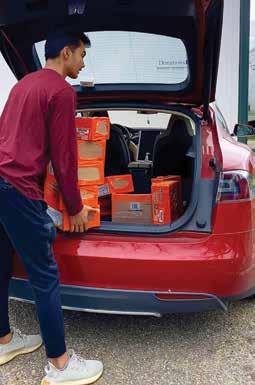
2 minute read
Advancing Human-Machine Partnerships
Mason researchers Dave Lattanzi, Brenda Bannan, and Amarda Shehu are leading the new Center for Advancing Human-Machine Partnership. Photo by Ron Aira
Advancing HumanMachine Partnerships
Your smartphone reminds you to go to a meeting. Pop-up ads recommend items you might want to purchase. Chatbots converse with you about shopping. Technology is woven into the fabric of our lives, and in the future, machines will be smarter and play an even bigger role in the workplace, education, and everyday tasks, says Mason Engineering’s Amarda Shehu, a professor of computer science. There will be an increasing interconnectedness between computing systems and the people who use them, agrees Dave Lattanzi, an associate professor of civil engineering. This interconnectedness will need to be transparent and interactive so people trust the systems they are working with, adds Brenda Bannan, an associate professor in the Division
of Learning Technologies in the College of Education and Human Development. To explore the best ways to navigate this new frontier, Shehu, Lattanzi, and Bannan are leading Mason’s new Center for Advancing Human-Machine Partnership (CAHMP). The interdisciplinary team includes faculty members from six schools and colleges at Mason, including the Volgenau School of Engineering. The purpose of CAHMP is to rethink human-machine partnerships and to design technology in a way that puts people in control, Shehu says. Mason researchers will conduct convergent research with experts from several disciplines uniting to look at problems in different ways. Computer scientists, psychologists, social scientists, human factors researchers, philosophers, policy experts, engineers, and education researchers will tackle fundamental questions about how machines can operate in a contextual setting, adapting to the people who guide them while engendering trust, Shehu says. According to Lattanzi, many people have social anxiety about relying on machines for decisions because they don’t understand and trust the systems that are being built. “In my field, we have wonderful robots and artificial intelligence systems to help in civil infrastructure, but people don’t use them because they don’t trust them,” he says. “I get the response, ‘This is great, but I don’t trust it to do as well as a human does.’ In reality, it’s better than humans are. We over-trust humans but under-trust machines.”
Lattanzi says that people will need to be able to trust and communicate with machines in the future for many purposes. For instance, autonomous vehicles need to know where passengers want to go and understand their needs, so passengers must be able to communicate back, he says. Shehu notes that machines are going to get more intelligent. “Right now, they aren’t very smart and are designed for specific tasks,” she says. “A movie recommendation system can only recommend movies. One direction where we want to go is general, integrated intelligence, such as a personal assistant that helps you with your day-to-day decisions, your health, and more.”
She hopes CAHMP, which has funding for five years, will be recognized as a leader in human-machine partnerships. “We are preparing for a time when humans and machines work together side by side, and we want to lead in this space,” she says.
—Nanci Hellmich
––Amarda Shehu, professor of computer science










